Before I begin to tell you about my amazing day at Parque Tayrona, I must admit that I skipped one stop.

After we left the pleasure hell of the beaches of Cartagena, we made it to Santa Marta, a city by the sea. A little colonial, a little touristy, a little average, but very unpretentious. A healthy mix of good crowds.
And adjacent to the fantastic natural reserve Parque Tayrona.
The Ruthless Drivers of Colombia
We came by bus. Special tourist bus, door-to-door service. Do these drivers drive smoother than others? ¡Hell no!
I got my driver’s license at the age of 25, practiced the art of driving for two years, and never felt very comfortable.
Then I gave away my car, went to Jamaica for a couple of months, and never sat behind a wheel again.
Hence, I’m certainly no driving expert.
But I know for sure: What these people are doing, is not right!
There is for instance the overtaking at blind curves – way up high on serpentines.
Then, we have the overtaking at spots marked with two continuous lines – definitely not there to give the road a fancy touch or make it look slim.
There is also overtaking on the right side of the car. Just to be clear: In Colombia, you are driving on the right side; or at least you’re supposed to do so.
Another cool thing to do is the simultaneous overtaking by two cars at a time. Hence, if you’re lucky, there are four cars side by side – the two cars overtaking the third one and another one in the opposite direction.
All this in a spot with a continuous line.
The advanced plunger does all this at blind curves. And preferably way up high on serpentines.
In a Hurry
If you are in a rush – and Colombians seem to be in a rush as soon as they sit in a car, you just go straight; on a very curved road that is.
Also known as cutting a curve.
Since the trips are long, drivers get bored just driving so they talk on the phone or even type WhatsApp messages.
Yesterday the cab driver wrote down my phone number with a pen on paper while driving. No, we won’t go on a date, he’ll take me to the airport on my last day.
On our way from Salento to Medellín over the Andes, we had to sit next to the bus driver because Mimi tends to get travel-sick.
Well, although the road was very windy and quite bumpy, she did not get sick. She was far too scared.
Never will I sit next to the driver again and see – I think ‘witness’ might be the better word – what he’s doing. I let him – with some help from Him – do his job without watching.
On the Road Again
Anyway, as we finally got to lovely Santa Marta, we spent only one night and continued the next morning to the nearby Parque Tayrona.
The Parque Tayrona – what can I say: Enchanted trails in a lush jungle. Exotic birds, bizarre critters, huge butterflies in bright colors, and curious monkeys. Halfmoon bays with turquoise waters.
To get a foretaste of paradise, just take the local bus to El Zaino, the main entrance to this protected garden Eden on the Caribbean coast of Colombia.
The park is a protected area on the foothills of the Sierra Nevada. There are various ways of visiting – and visiting you should definitely do.
Taganga, a dull, suburb-ish town about 10 minutes from Santa Marta, is actually already the Parque’s southernmost point. This gives you an idea of how close you already are once you reach lovely Santa Marta.
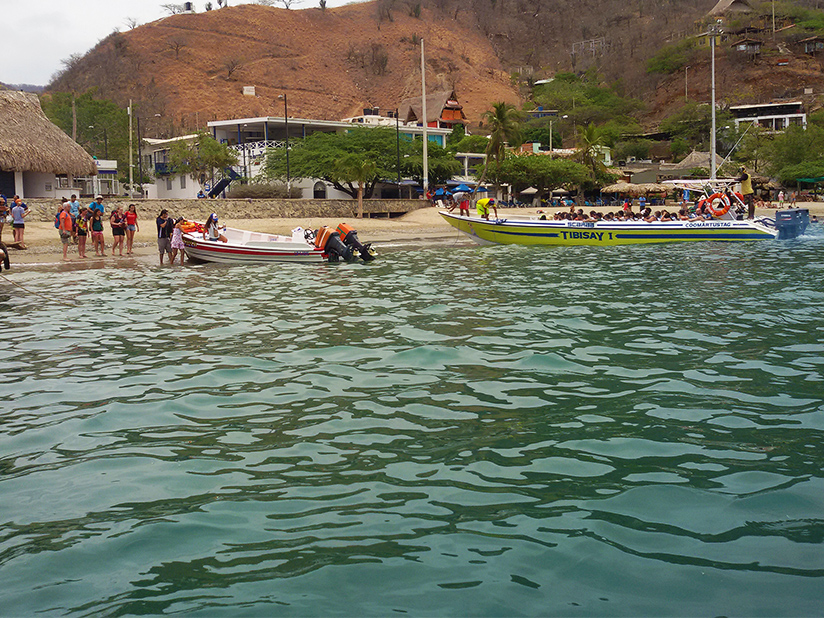
We had left our big luggage at our guesthouse in Santa Marta and took only a small backpack with us. After all, we spent the Easter weekend further East – no pun intended.
We had planned two stops: One at the Parque Tayrona and the other one at Palomino.
It’s a Walk in the Park
The Parque Tayrona is a national park that stretches more than 20 miles along the Northern Caribbean coast. It attracts nature lovers not only because of its impressive flora and fauna but also due to its many secluded, unspoiled beaches.
Secluded means – once again – hiking. It starts harmless on straight wooden walkways, but this bliss doesn’t last.
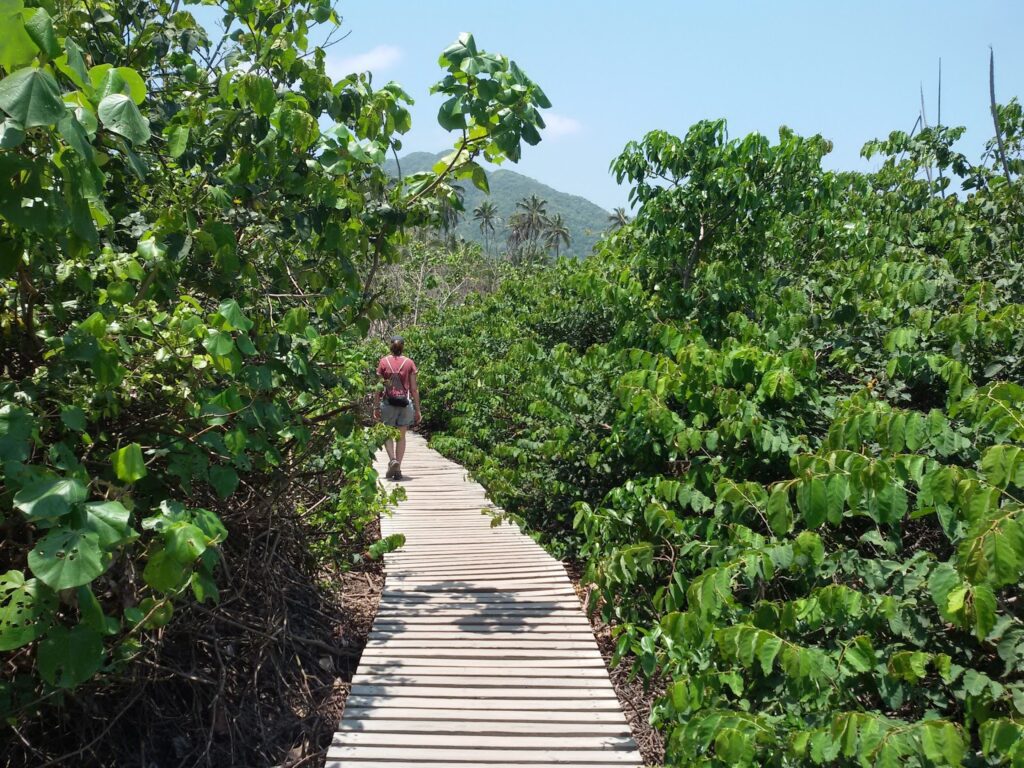
Soon you have to climb up and down quite steep stairs and dirt trails and it’s really hot and humid. You are hiking through a really impressive jungle with some rough and mountainous parts to secluded, unspoiled beaches which is very nice, but in the heat and humidity exhausting.
A Foretaste of Paradise
The variety of the flora and fauna is amazing – some of this biodiversity is even endemic to this region. You get to see majestic birds, exotically glittering lizards, huge butterflies in bright colors, and even monkeys.

Coming from El Zaino, the first beach, Playa Cañaveral, looks very inviting – especially after the exhausting hike. But do yourself a favor and take the warning seriously: The waves and the undercurrent here are really dangerous. Just clench your teeth and postpone your dip till you reach the following bays – you’ll enjoy it so much!
Yes, it’s a great place, but when we finally reached the beach after only 90 minutes, I was much more exhausted than after our five hours hike in the mountains of Valle Cocora.
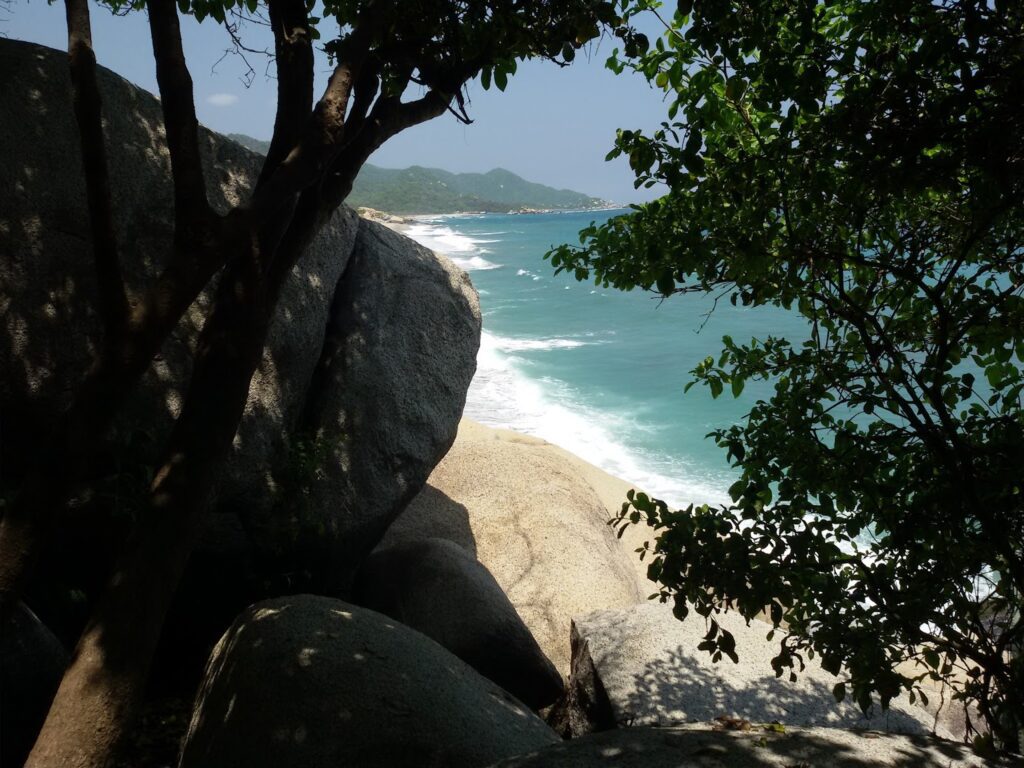
Mountains are key here: There, in the coffee region, it had been relatively cool. Here, on the Caribbean coast, it was a frigging hothouse!
So once we got to the first of many beautiful beaches, I took a dip in the crystal clear ocean and simply crashed in the shade of one of the lush trees. Until it was time to make it back.
As always, the way back seemed much easier – also because it was later in the day hence cooler.
What You Need For Your Visit
It’s important that you have your documents with you, i. e. an ID or, even better, your passport. A yellow fever vaccine is not indispensable but recommended.
Don’t forget to use sun protection and take more with you.
Repellent is optional – probably recommended if you spend the night.
Good sneakers or preferably hiking shoes are crucial – this is a national park, a jungle, not an English garden.
Clothing should be sensible and hardwearing and fast-drying.
At least for the first two hours, you should have enough drinking water with you. Again, although this is not an expedition, the climate makes a visit really demanding.
We visited the park only for one day, but to make the most of your visit, I would recommend at least two or three.
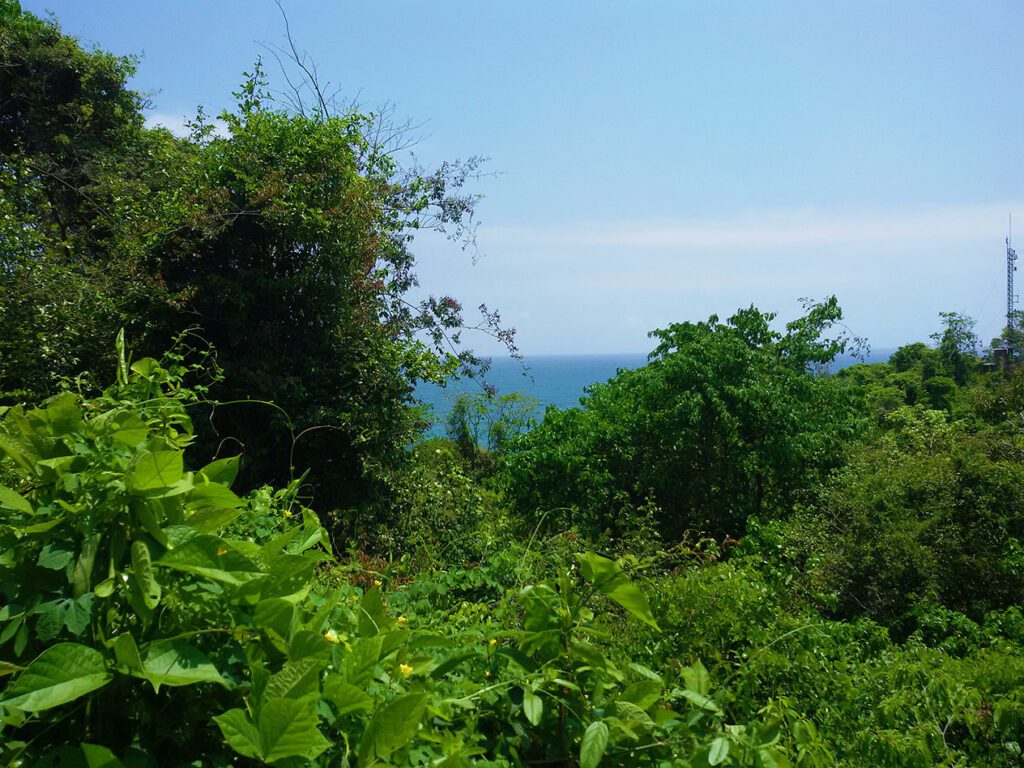
As I said, we got into the park at the El Zaino entrance.
However, you can also enter at Calabazo. Then, you’ll have to walk much longer to reach the beaches, but you hike the hills covered by lush rainforest. It’s nice, but really hard – with a capital H.
The easiest way, however, is to come by boat from Taganga. You hop on a boat and after about 40 minutes, they drop you off on one of the beaches.
Of course, you still have to buy an entrance ticket.
Practical Information
Hot to Get There And Around
There is a public bus leaving Santa Marta at the stop next to the Central Market on Calle 10 with Carrera 9 where any cab takes you for as little as US$1,
Here, you have to catch the local public bus towards La Guajira. You can just tell the driver where you want to get off.
We went to the main entrance El Zaino in Cañaveral, but if you are more adventurous, it’s also possible to enter the park at Calabazo.
Best Place to Sleep
As we planned on continuing further east to Palomino the following day, we booked a room at the Recuerdos del Tayrona guest house* right next to the main entrance to spend the night. It also came in handy since we were able to leave everything we didn’t urgently need for our hike in our room.
There are also accommodations right at the park. However, those are either quite rustic – like hammocks, tents, and beds without real walls – or pretty expensive. Whereby the open-air beds are quite costly, too.
On the other hand, if you spend the night in the park, you have to pay the entrance fee of about 15 $ only once. So you need to do the math yourself according to your interest.
One might think that at night you’d have the chance to get a better look at the wildlife; thus while we hiked back, loud Salsa and Reggaeton were blaring from the campground, so I’m not sure how far that actually attracts wildlife.
The Recuerdos del Tayrona guest house* is about three minute’s walk from the El Zaino entrance. The rooms are rather simple and rustic, but clean and the owners are super friendly and welcoming.
It’s a great place to leave everything you do not urgently need for your visit to the Parque. However, in case they are booked out, here are some more great lodging options*:
Booking.comBest Place to Eat
To be honest, there aren’t that many options for where to eat so the best place was not difficult to pick – and we picked Restaurante Las Acacias.
However, the food was good – and the seating on their terrace next to the river was nice.
It’s located pretty much right across the El Zaino entrance.
What Else There Is To Do
I’m an avid solo-travelling woman. Since solo travel doesn’t equal solitude, I love to join organized tours here and there. They allow me to meet fellow travellers – for just a short moment or a lifelong friendship.
Therefore, here are more great ideas of what to do during your stay in the region. They’ll enable you to explore amazing places in a comfortable and most importantly safe way*:
The Parque Tayrona was only one of many beautiful places I’ve visited in Colombia. To read about the others, go to the main post and take your pick! There you’ll also find valuable general information that will make your trip smoother.
Pinnable Pictures
If you choose to pin this post for later, please use one of these pictures:
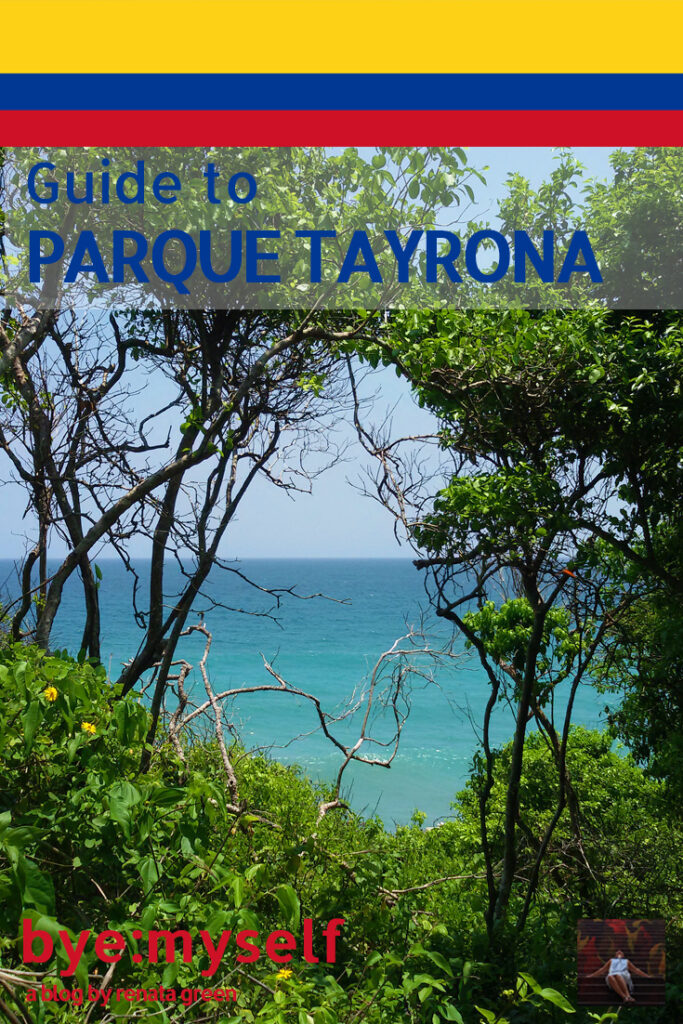
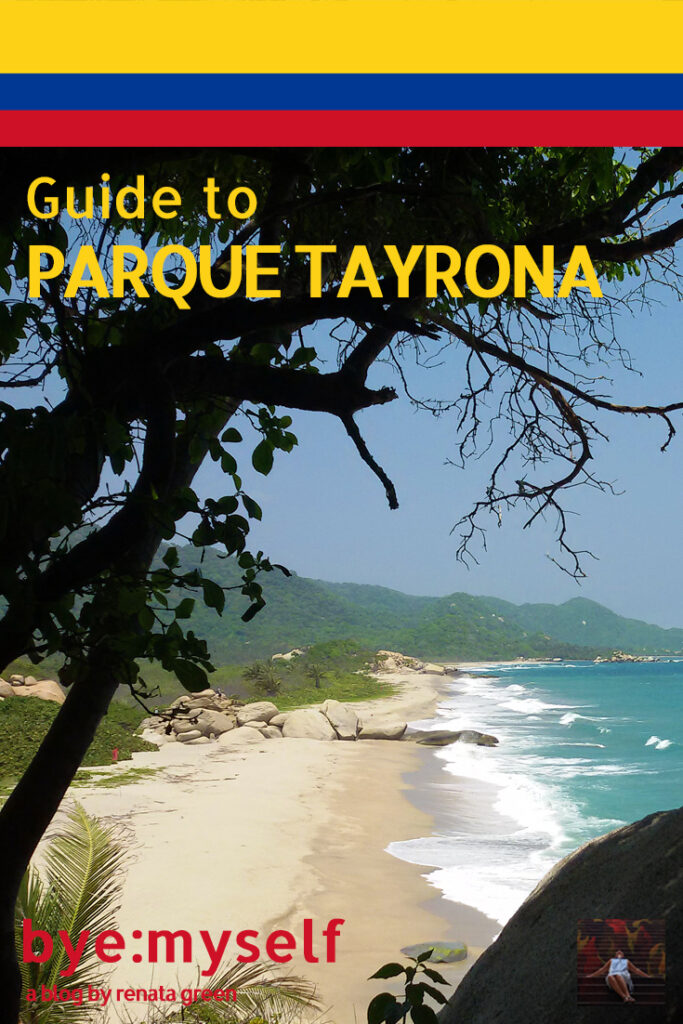
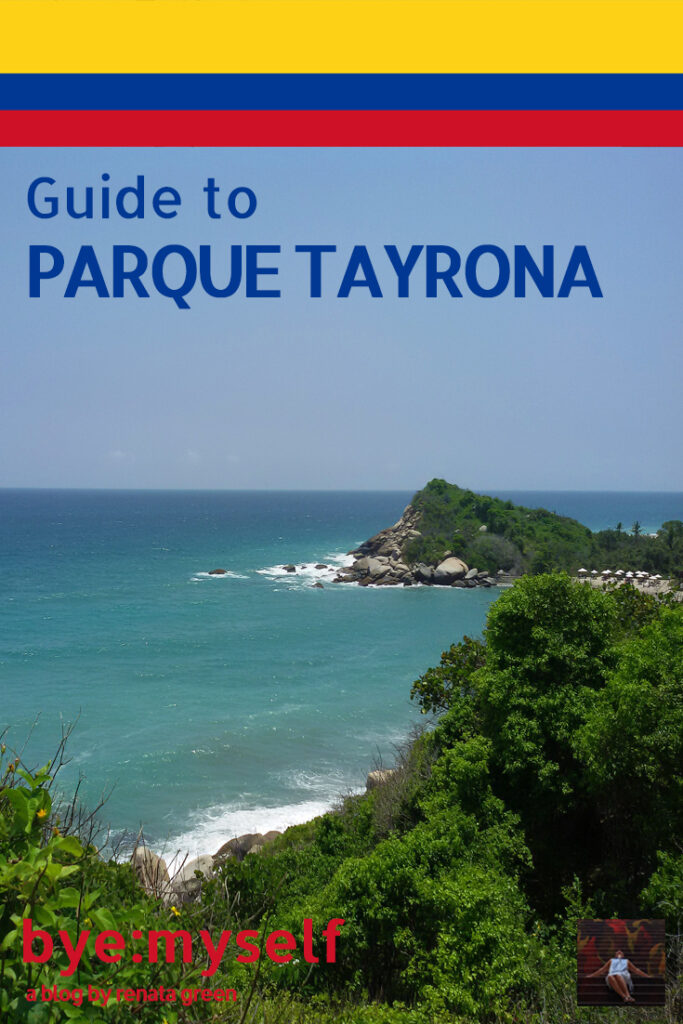
Note: This post is being regularly completed, edited, and updated – last in November 2022.
Did You Enjoy This Post? Then You Might Like Also These:
Solo in COLOMBIA – a comprehensive guide
Guide to CALI – And a Day Trip to Paradisiac Haciendas
SALENTO – Fifty Shades of Green in Colombia’s Edenic Coffee Region
Guide to MEDELLÍN – And a Day Trip to GUATAPÉ
Two Days in CARTAGENA
SANTA MARTA – Spectacularly Unspectacular
A Day at PARQUE TAYRONA
Guide to BOGOTÁ – Colombia’s hip ‘n’ artsy capital
* This is an affiliate link. If you book through this page, not only do you get the best deal. I also get a small commission that helps me run this blog. Thank you so much for supporting me!

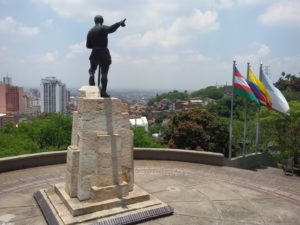
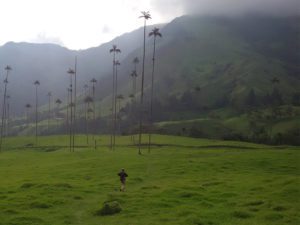
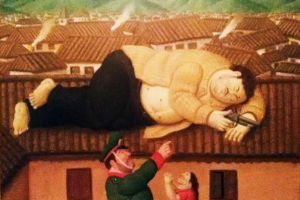


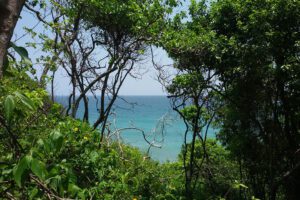
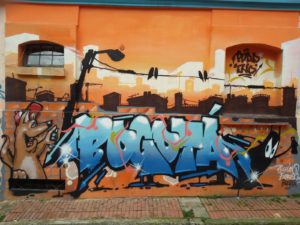
I can just imagine you crashing after the hard hike. Sounds like a great day but can there be an easier way to go through the thick jungle to the seclu?ded beach
Columbia sounds amazing, but scary to go to. Mainly, because of the driving. Other then that it sounds like a place to get your adventure-driven mindset going. The Parque Tayrona sounds like a challenge but ending with a great goal reached.
Unfortunately, there are many places that are scary when it comes to driving. I try to ignore it and count on my guardian angel 😉
You certainly have a way with your story telling lol. I have noticed that taxi drivers throughout the Carribean don’t much like to pay attention to the road. It can get pretty scary at times. I also travel solo and many times join a tour in order to meet other people. I also find that you learn more of the history while on tour.
Totally – and after my accident, I’ll also join groups for security reasons 😉
I’ve experienced that kind of crazy driving when traveling. It can be quite scary. I’m glad you’re safe.
Yap, I’ve had some breathtaking experiences on the road in many countries. My heart still skips a beat 😉
Thanks for the tips about how hot and humid it is and how much that makes a difference to the effort level of the walks and hikes you describe. Any exercise in a sauna-like environment is much more difficult! Although, I don’t mind it, but my wife and son would not be as thrilled.
Yes, every step in that climate is exercise 😀
I have a good friend that is from Columbia. She tells me all the time what a beautiful country and shares her photos with me.
It’s one of my favorite countries 🙂
You had me hooked until you said up and down steep stairs. I would never make it. LOL Still a beautiful trip!
Yes, although there were wooden planks, it was exercise – especially due to the hot’n’humid climate. 😉
Nice photos and I love nature where you could get into the water than the hills. Had no idea there is so much to see and do in Parque Taytona – enjoy the read. – Knycx Journeying
I can just feel the beach calling me! Thanks for touring us around the place! It sounds beautiful!
Wish lockdowns and covid ends so we can do all these travels too, thanks for sharing as if we are sight seeing too with nice shots of photos there!
Wonderful place and experience! All of the pics are beautiful. I hope to get to visit there someday.
Wow what an adventure you had! Parque Tayrona looks like a beautiful and exciting place to visit!
It was such a beautiful hike 🙂
Oh, wow. The beach and the views of the surroundings all look marvelous. I love this spot in Colombia.
We had a marvelous day out 🙂
We had only a small taste test of Columbia when we visited and it has been on our list of places to re-visit. We always debate the virtues of renting a car. But I will heed your cautions about the taxis when assessing options. We would definitely want to visit Park Tayrona. Great to know that the wooden path is a tease and that there is real hiking through the jungle. But those great waters look like it would be worth the effort.